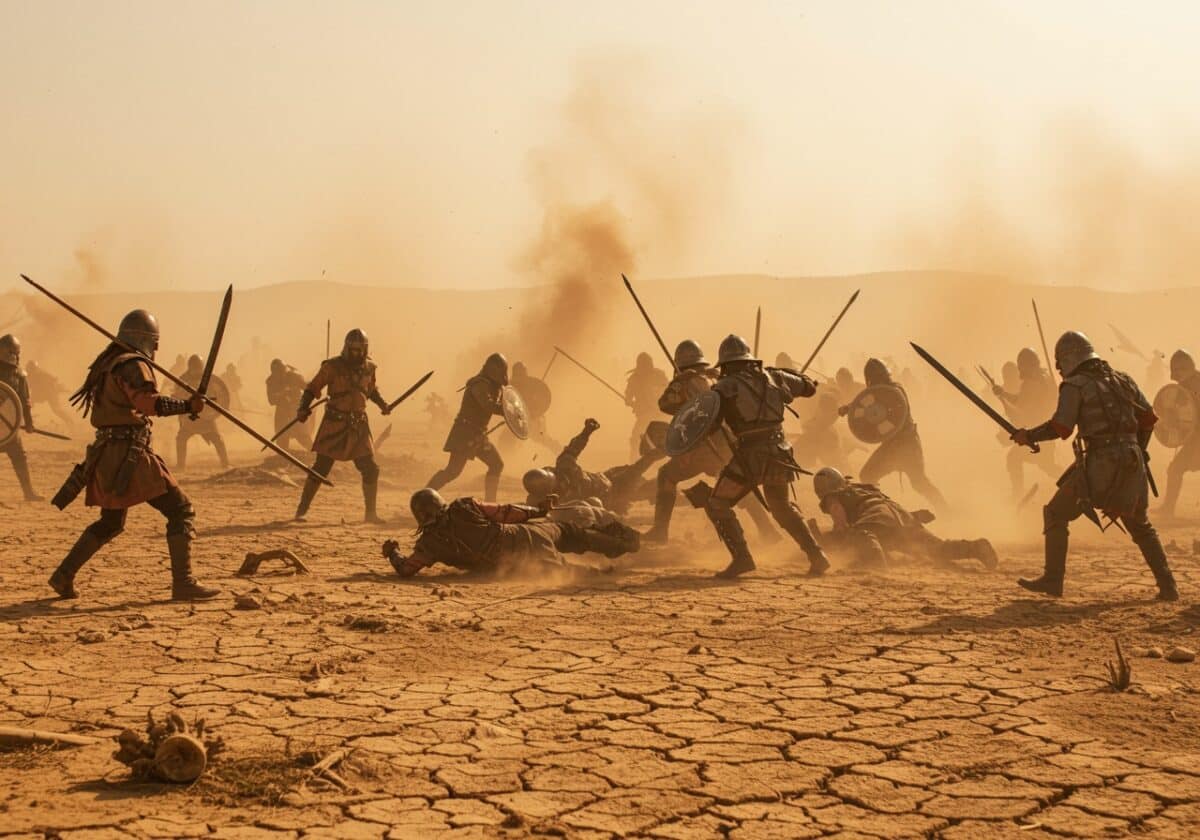
Extreme drought likely preceded the Barbarian Conspiracy in ancient Roman Britain. (Photo by StudyFinds on Shutterstock AI Generator)
In a nutshell
- Tree-ring data shows southern Britain endured three back-to-back droughts from 364 to 366 CE, likely triggering food shortages that weakened Roman control and helped set the stage for the “Barbarian Conspiracy” invasion in 367 CE.
- The study links climate extremes to conflict across the Roman Empire, revealing that battles in the Western Empire were often preceded by hot, dry summers, with a sharp spike in droughts three years before major clashes.
- Researchers warn that this ancient case holds lessons for today, as modern climate change could similarly strain food systems and social stability, increasing the risk of conflict in vulnerable regions.
CAMBRIDGE, England — Extreme weather, not just barbarian hordes, may have helped bring down Roman Britain. A brutal three-year drought that ravaged Roman Britain in the 360s CE likely helped trigger a catastrophic military defeat known as the “Barbarian Conspiracy” that ultimately contributed to Rome’s withdrawal from Britain, according to a new international study.
Scientists have discovered that southern Britain experienced exceptionally dry summers from 364 to 366 CE, creating conditions not unlike modern droughts that devastate crops and cause food shortages. This climate disaster appears to have destabilized Roman authority just before multiple tribes launched coordinated attacks on the province in 367 CE.
The findings, published in the journal Climatic Change, show how climate extremes can topple even the most powerful empires when they strike at vulnerable moments.
Despite ongoing studies, the reasons behind both Roman Britain’s abandonment around 410 CE and the Western Roman Empire’s collapse in 476 CE remain unclear. This study combines tree-ring climate data with historical accounts and archaeological evidence to show how environmental factors may have helped destabilize Roman rule.

“We don’t have much archaeological evidence for the ‘Barbarian Conspiracy’. Written accounts from the period give some background, but our findings provide an explanation for the catalyst of this major event,” says first author Charles Norman from Cambridge’s Department of Geography, in a statement.
The research team reconstructed ancient rainfall patterns using tree rings preserved in old timbers, finding that the years immediately preceding the Barbarian Conspiracy were catastrophically dry. In 364 and 365 CE, southern Britain received just 54-58% of normal spring and summer rainfall, comparable to modern droughts that have caused widespread crop failures.
In the period 350–500 CE, average monthly reconstructed rainfall in the main growing season (April–July) was 51 mm. But in 364 CE, it fell to just 29mm. 365 CE was even worse with 28mm, and 37mm the following year kept the area in crisis.
“Three consecutive droughts would have had a devastating impact on the productivity of Roman Britain’s most important agricultural region. As Roman writers tell us, this resulted in food shortages with all of the destabilizing societal effects this brings,” explains study author Ulf Büntgen, from Cambridge’s Department of Geography.
Between 1836 and 2024 CE, southern Britain only experienced droughts of a similar magnitude seven times, mostly in recent decades, and none of these were consecutive, emphasizing how exceptional these droughts were in Roman times. The researchers found no other major droughts in southern Britain during the studied period (350–500 CE), while other parts of northwestern Europe experienced more normal conditions.
Romans in Britain primarily cultivated “spring-sown” crops like spelt wheat and six-row barley. These crops were particularly vulnerable to early summer moisture deficits, making them susceptible to complete failure during drought conditions. Unlike today’s winter-sown varieties, these ancient crops relied heavily on spring and early summer rainfall.

By 367 CE, written records describe Britain suffering extreme famine. That winter, portions of the garrison on Hadrian’s Wall rebelled and allowed northern tribes called Picts to attack Roman territory. Simultaneously, Scots from Ireland invaded western Britain while Saxon raiders from continental Europe struck from the south.
The military leadership collapsed when the commander of the “Saxon Shore” was killed and another senior general captured. Small bands of invaders then plundered the countryside throughout spring and summer, throwing the province into anarchy.
Emperor Valentinian I dispatched his trusted general, Theodosius the Elder, who took two years to restore order. Despite this recovery, archaeological evidence suggests the province never fully regained its former stability before Rome’s complete withdrawal around 410 CE.
“Our findings align with the accounts of Roman chroniclers, and the seemingly coordinated nature of the ‘Conspiracy’ suggests an organized movement of strong onto weak, rather than a more chaotic assault had the invaders been in a state of desperation,” says study author Andreas Rzepecki from the Generaldirektion Kulturelles Erbe Rheinland-Pfalz.
The severe, extended drought hit Roman Britain at an already difficult time, when the province was losing food and military supplies to support the Rhine frontier and facing growing migration pressures. With its resilience already stretched thin, these combined stresses made it easier for internal unrest and outside attacks to break through the weakened defenses.
The research extended beyond Britain to examine 106 major battles across the entire Roman Empire from 350 to 476 CE. The team found clear patterns linking climate extremes to conflict throughout this period.
Climate records for Western Empire battles show a significant increase in unusually warm and dry conditions one to five years before conflicts. Extreme conditions peaked three years prior to battles, matching exactly the interval between the drought’s onset and the Barbarian Conspiracy.
In contrast, the Eastern Roman Empire showed different patterns, with conflicts often preceded by unusually wet conditions rather than drought. This aligns with historical evidence that the Eastern Empire maintained greater political stability and environmental resilience than its western counterpart.
“The relationship between climate and conflict is becoming increasingly clear in our own time, so these findings aren’t just important for historians. Extreme climate conditions lead to hunger, which can lead to societal challenges, which eventually lead to outright conflict,” says study author Tatiana Bebchuk from Cambridge’s Department of Geography.
In our warming world, climate scientists have warned that climate change will likely increase water and food scarcity in some regions, potentially heightening conflict risks, as it probably did in ancient times.
While modern food systems provide greater resilience through international trade and technological advances, climate-driven crop failures can still trigger food price spikes, economic pressure, and political instability, especially in regions with limited resources or existing tensions.
It’s a chain reaction. Multi-year droughts trigger crop failures, which, depending on existing societal resilience, cause food shortages. These shortages create economic pressure and societal instability that can eventually erupt into conflict. Environmental extremes can trigger cascading societal failures even in the most powerful civilizations of their time – a sobering parallel to the challenges our warming world now faces.
Paper Summary
Methodology
The researchers used tree-ring data to reconstruct climate conditions in southern Britain and across the Roman Empire. They collected oak tree-ring width series from southern Britain and northern France (spanning 288-2009 CE) and calibrated them against modern instrumental records to create an April-July precipitation reconstruction. They also compiled a database of 106 major Roman battles from 350-476 CE and used “event-based aggregation analysis” to explore relationships between climate extremes and conflict timing. The team standardized climate values for the years surrounding each battle and counted how many years exceeded defined thresholds for extreme conditions.
Results
Southern Britain experienced three exceptionally dry summers from 364-366 CE, with precipitation levels at only 54-58% of normal. These years immediately preceded the “Barbarian Conspiracy” of 367 CE, when multiple tribes invaded Roman Britain amid reports of extreme famine conditions. Coin hoarding patterns and archaeological evidence support historical accounts of societal breakdown. Analyzing conflicts across the Empire revealed statistically significant patterns: battles in the Western Empire were commonly preceded by warm, dry conditions 1-5 years earlier (most significantly 3 years prior), while Eastern Empire conflicts were often preceded by unusually wet years. The study concludes that climate-induced agricultural failures likely contributed to military instability, creating opportunities for invasion through a weakened Roman Britain.
Limitations
The study acknowledges uncertainties in dating and details of ancient events nearly 1,700 years ago. Available historical and archaeological sources provide limited temporal resolution. The researchers note they are not attempting to simplify the complex political and economic factors affecting Roman Britain, but rather identify climate as a potential catalyst that may explain the scale and abrupt nature of the breakdown. The Eastern Roman Empire analysis was limited by relatively sparse paleoclimate proxy archives for that region.
Funding
Charles Norman was supported by Wolfson College, University of Cambridge (John Hughes PhD Studentship). Ulf Büntgen received funding from the Czech Science Foundation (# 23-08049S; Hydro8), the ERC Advanced Grant (# 882727; Monostar), and the ERC Synergy Grant (# 101118880; Synergy-Plague).
Publication Information
The study, “Droughts and conflicts during the late Roman period,” was published in April 2025 in Climatic Change (volume 178:87) by researchers from the University of Cambridge, Generaldirektion Kulturelles Erbe Rheinland-Pfalz (Germany), the Czech Academy of Sciences, and Masaryk University (Czech Republic).







